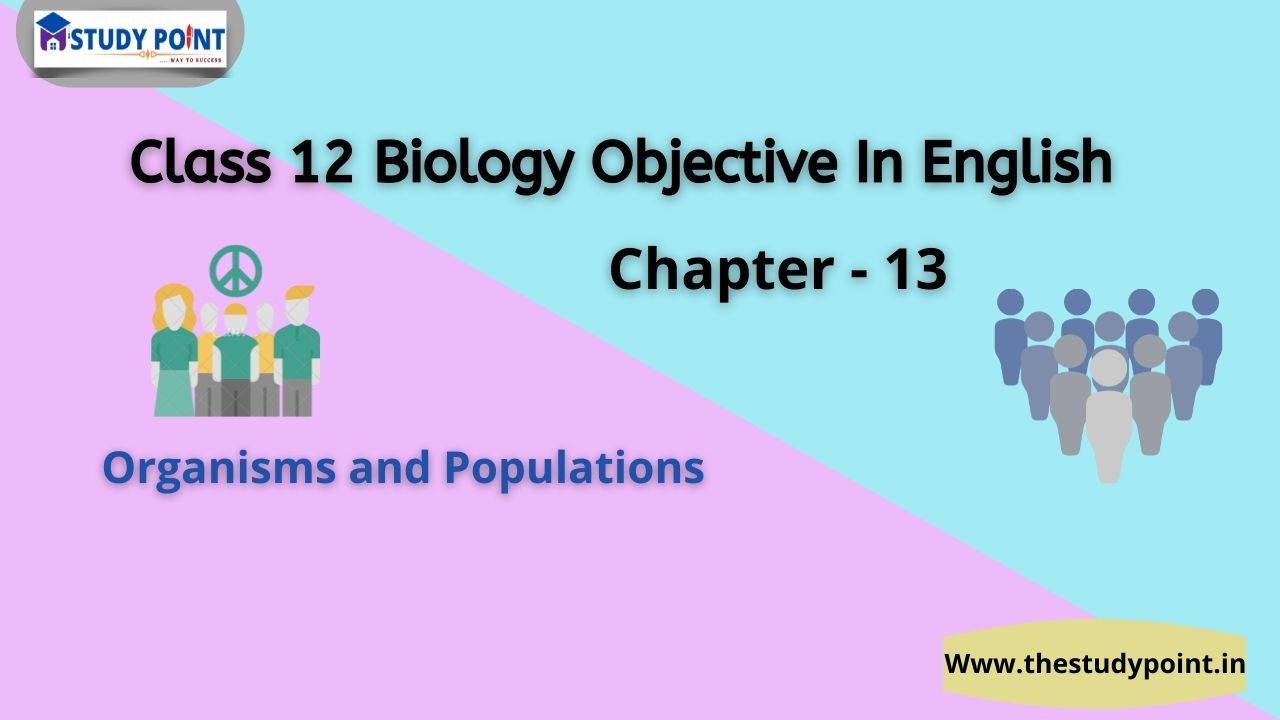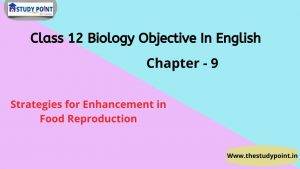Here we are providing Class 12 Biology Objective In English Chapter – 13 Organisms and Populations include all questions presented in the Biology Class 12 books. Candidates can enlist the help of the Biology Class 12 Objective in English on the next page and gain a deeper understanding of the concepts. Class 12 Biology Objective in English Chapter – 13 Organisms and Populations is designed by our team of subject matter experts to help students prepare for exams. English students can view the PDF of the Class 12 Biology Objective on the page below. From the Biology Book English Questions and Answers on this page, students will learn how to correctly solve problems.
Remember that the Class 12 Biology Book Objective is the best resource for a good study of the 16 chapters. Use the Class 12 Biology Book Objective as a reference and keep practicing with the answers to questions and exercises until you improve your answers to all chapters of your Class 12 Biology Program. Class 12 Biology Objective in English Chapter – 13 Organisms and Populations will help you solve all Class 12 Biology questions chapter 13 smoothly. if you want more notes for various subject then click here
Class 12 Biology Objective In English Chapter – 13 Organisms and Populations
1. Number of deaths during a limited time period and place for a particular population is known as
( A ) Natality
( B ) Mortality
( C ) Migratory
( D ) Integrity
Ans-( B )
2. Climax community is present in which area ?
( A ) In equilibrium
( B ) In transition
( C ) Bare land
( D ) None of these
Ans-( A )
3. The maximum number of species has been extincted from :
( A ) islands
( B ) mainland
( C ) oceans
( D ) fresh water bodies
Ans-( A )
4. Loss of relative biological equilibrium is due to :
( A ) low temperature
( B ) high temperature
( C ) radiation
( D ) pollution
Ans- ( D )
5. The value of Biological potency is measured by
( A ) Birth rate Death rate
( B ) Birth rate + Death rate
( C ) Birth rate : Death rate
( D ) None of above
Ans-( A )
6. The bacteria Rhizobium present in soil in which way take part in the population growth of plants ?
( A ) By Nitrogen-fixation & increase in soil fertility.
( B ) By Fungal roots
( C ) By commensalism
( D ) None
Ans-( A )
7. The shallow-water region near by Pond is called
( A ) Littoral zone
( B ) Limnetic zone
( C ) Profundal zone
( D ) Benthic zone
Ans-( A )
8. Animal that can tolerate water loss equal to one third body weight is :
( A ) Necturus
( B ) Camel
( C ) Lizard
( D) Chiton
Ans-( B )
9. In commensalism :
( A ) Both partners are benefitted
( B ) Both partners are harmed
( C ) Weaker is benefitted while stronger is unharmed
( D ) None of the above
Ans-( C )
10. A successful parasite is the one which :
(A) Grows rapidly
(B) Reproduces fast
(C) Sticks to host for long
(D) Makes minimum demands from its host
Ans-( D )
11. The formula for Log/ Exponential growth is :
( A ) dt/dN
( B ) IN/N = dt
( C ) rN/dN = dt
( D ) dN/dt = rn
12. Unrestricted reproductive capacity is:
( A ) Birth rate
( B ) Carrying capacity
( C ) Biotic potentiality
( D ) Fertility
Ans-( C )
13. One who secures food at the costof others is :
( A ) Parasite
( B ) Insectivore
( C ) Commensal
( D ) Saprophyte
Ans-( D )
14. Frog feeding on herbivorous insect is:
( A ) Primary consumer
( B ) Secondary consumer
( C ) Tertiary consumer
( D ) Top carnivore
Ans-( B )
15. Mutualism occurs between :
( A ) Butterfly and flower
( B ) Escherichia coli and man
( C ) Zoochlorellae and Hydra
( D ) Hermit Crab and Sea Anemone
Ans-( C )
16. The maximum growth rate is in
( A ) Senescent phase
( B ) lag phase
( C ) Exponential phase
( D ) Stationary phase
Ans-( C )
17. Which in the following has root cap?
( A ) Xerophyte
( B ) Mesophyte
( C ) Hydrophyte
( D) Hallophyte
Ans-( C )
18. The mycorrhiza is an example of
( A ) Symbiotic interaction
( B ) Ectoparasite
( C ) Endoparasite
( D )Decomposer
Ans-( A )
19. Lichen is the association of
( A ) Algae & algae
( B ) Algae & fungi
( C ) Algae & higher plant roots
( D ) Fungi & fungi
Ans-( B )
20. The region of atmosphere near theearth is called
( A ) Stratosphere
( B ) Mesosphere
( C )Trophosphere
( D )Thermosphere
Ans-( C )
21. Which in the following has highest number of species?
( A ) Birds
( B ) Angiosperms
( C )Fungi
( D ) Insects
Ans-( D )
22. Hibernation occuring in certainanimal is :
( A ) Rhythmic
( B ) Periodic
( C ) Occasional
( D ) Intermittent
Ans-( B )




